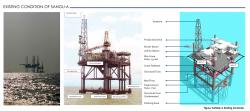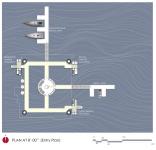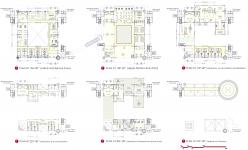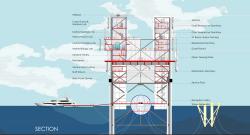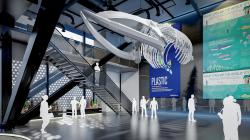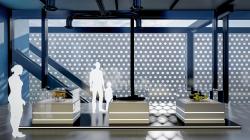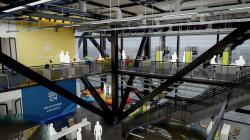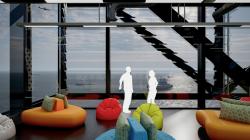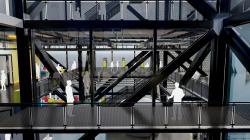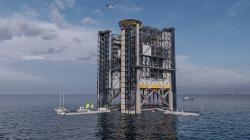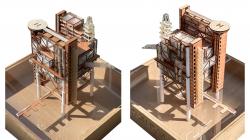Salvaged Island - An Alternative Architectural Solution to use Aquatic Infrastructure as an Integrated Facility.
Sangu-A is the first offshore Gas Rig project in Bangladesh. This gas field was discovered in 1996 in the Bay of Bengal 35-40 km away from the land near Salimpur, Chattogram . In 1998 the offshore Gas Rig was built by Petrobangla with the help of two international companies Cairns ltd and Santos Ltd. Later in 2013 due to lack of Gas production the offshore Gas Rig was decommissioned and abandoned.
An oil platform, offshore platform, or offshore drilling rig is a large structure with facilities for well drilling to explore, extract, store, and process petroleum and natural gas that lies in rock formations beneath the seabed. There are about 175 offshore Rigs in the Gulf of Mexico and 184 in the northern sea. After these gas reservoirs run out of gas the Rig structures are abandoned in the middle of the sea as the cost of removing a shallow water Rig is almost around 5-20 million USD varying in size.
An official of Petrobangla, seeking anonymity, said: “Though the Sangu gas field has not been used since its shut down, Tk1 crore is being spent for its maintenance every year.”
So, The aim of this study/project is to show how architecture can revive such an aquatic infrastructure like Sangu-A through an adaptive reuse, which will define a starting point for a long term strategy of reusing designated abandoned aquatic infrastructures as an alternative to demolishing.
Considering the unique geographical location of the existing structure, a concept behind this adaptive re-use can be generated. Concept: Satellite of the Sea.
The adaptive re-use of Sangu-A will also act like a satellite placed distant in the sea yet it will provide important information and provide communication. This will become a station which will investigate the sea and sea life and also promote tourism and education signifying the presence of Bangladesh in the middle of the Bay of Bengal. The structure will house a Marine and Oceanographic Research Station with supervision of BORI(Bangladesh Oceanographic Research institute), a Visitors Center for tourism and a Coast Guard check post to enhance ocean security.
The massing has been generated through Wind data simulation as the wind is an important issue in this site and also proper screening is provided in the structure to resist Wind flow, Sunlight and Heat.
In the docking zone researchers, visitors and service goods are divided using 3 different vertical circulations. On the upper floors, under the existing platform the admin and service zones of the facility is placed. And from the floors situated over the platform Laboratories, Restaurants, Exhibition Space, Visitor accommodation etc have been placed. There are 4 types of Marine Laboratories here, Marine Physics, Marine Chemistry, Marine Biology and Marine Geology which are all designed with proper sanitation, documentation and leisure zone. Also for visitors and Researchers accommodation a total of 48 rooms have been provided. To control the whole facility a floor has been kept to provide a proper admin ad staff section including offices, canteens and accommodation for staff as well. Proper fire safety, helipad etc is also a part of the facility.
As the structure is situated in the the sea sustainable electricity will be generated from Solar Energy through photovoltaic panels in the façade. Using 150w solar panels in the south façade almost 15% of the facilities total consumption can be generated.
As Wind speed is more than usual here in the sea electricity will also be generated here through Vertical Axis Wind Turbines (VAWT) in the facades. Almost 18% of the total electricity consumption is generated from Vertical Wind Turbines situated in the North and South façade as Wind in summer comes from south and in winter comes from north.
Electricity will also be generated here through the use of Floating Modular Wave Generators generate electricity from the up-down motion of waves. 4-5 generators of 750kW can generate total energy of the facility.
The project shows how a multistoried building can be designed using an existing structure in the sea. The adaptive re-use of the Gas Rig provides new life to an old structure rather than demolishing it and also creates an example of how a building can be run through sustainable energy which also creates new opportunity in research and tourism.
2021
2021
Site Area: 1 Acre
Site Location: 17 km offshore Chittagong in the Bay of Bengal
Designer: Mahir Aritro
Project Supervisor: Amit Imtiaz
Studio Mentor: Kanu Kumar Das, Shajib Paul
Favorited 1 times


